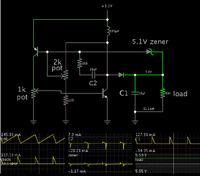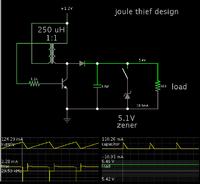neazoi
Advanced Member level 6
Hello I have made this power inverter https://www.eleccircuit.com/step-up-dc-converter-1-2v-to-5v-5v-for-micro-computer/ for a microcontroller project that uses a atmega644 and two 24c512. I have used a 1n5711 for the schottky and I have not built the negative voltage section.
The micro seems to start at 4.3-4.4v but the maximum loaded output I can get out of the inverter is 4.2v (using a 5.1v zener)
The micro draws less than 1mA I do not know why the drop in the voltage is happening. Anyway the unloaded voltage is 5.1v the same as the zener, but the loaded voltage as I said is 4.2v.
Is there anything I can do to boost this voltage to more than 4.5v instead of 4.2? MAybe more turns on the coil or...?
The micro seems to start at 4.3-4.4v but the maximum loaded output I can get out of the inverter is 4.2v (using a 5.1v zener)
The micro draws less than 1mA I do not know why the drop in the voltage is happening. Anyway the unloaded voltage is 5.1v the same as the zener, but the loaded voltage as I said is 4.2v.
Is there anything I can do to boost this voltage to more than 4.5v instead of 4.2? MAybe more turns on the coil or...?

